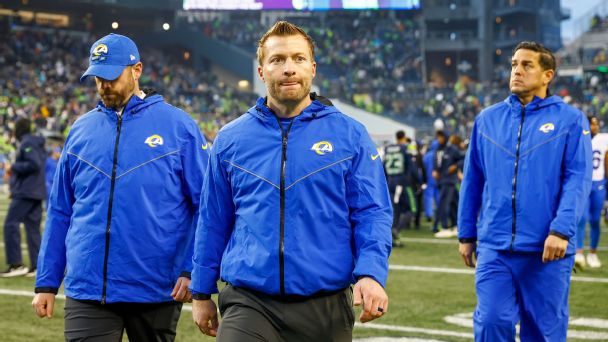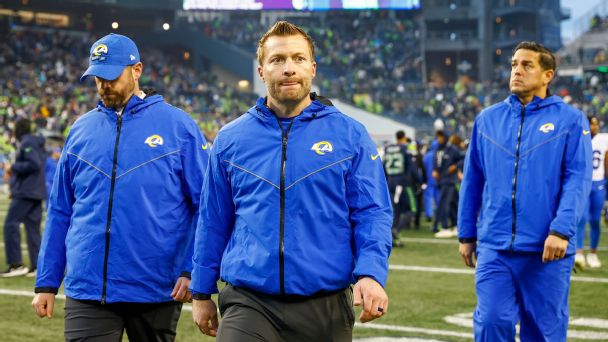
LOS ANGELES — In recent years, when a big-name player has been available on the trade market, the talk around the league is whether the Los Angeles Rams would be interested.
This offseason — one headlined by the Rams trading away star cornerback Jalen Ramsey — there was no such chatter.
“We’re the boring Rams this year,” general manager Les Snead quipped at the league’s annual meetings.
Coming off the worst season since coach Sean McVay was hired in 2017, the Rams’ offseason hasn’t been defined by splashy moves — such as trading for quarterback Matthew Stafford in 2021 or in-season moves to land linebacker Von Miller and receiver Odell Beckham Jr. Instead, the Rams have intentionally hit the brakes this offseason, pausing with their aggressive approach in 2023 in an attempt to not have to tear down this top-heavy roster and instead set themselves up to be competitive in the trade market and in free agency as early as 2024.
This is the consequence of going all-in the last four years as they tried to win a Super Bowl. Instead, Snead said, there’s “definitely been intent to engineer a healthier, more sustainable cap situation so that when we do get to a moment where we think, ‘OK, let’s press the gas again,’ you have the capability to do it.”
This offseason will be focused on building through the draft, something Snead called “really the heartbeat of the franchise,” adding, “if we truly believed in f—ing them picks in that sense of the word, we’d just give them to our division opponents and not use them.” Los Angeles is scheduled to make 11 picks in April’s draft, including three in the top 100; last year, the Rams’ first pick came at No. 104.
While this feels like a big pivot from what has been perceived as the Rams’ primary model, it’s really another attempt by Los Angeles’ front office to try to continue to be innovative in roster-building and not have to go through a total rebuild. While Rams COO Kevin Demoff made it clear Los Angeles is not punting on the 2023 season, this has been viewed as sort of a set-up year for 2024, when the Rams anticipate having $55 million to $65 million in cap space.
“We always knew, OK, there’s going to be that moment we … press the brakes a little bit,” Snead said. “And really it’s to reset, retool to be able to figure out who we are. And once we figure out who we are is when we begin maybe being aggressive or exciting.”
“DISCIPLINE” IS THE word McVay keeps coming back to while describing the offseason process the Rams are going through. Los Angeles could, Demoff acknowledged, keep “maxing out” credit cards “and walking back into the department store and keep spending” by restructuring contracts to create salary cap space, but the franchise has been adamant that’s not the way they want to continue to build their team.
“We’ve always tried to take as much pain as we can as quickly as we can,” Rams VP of football and business administration Tony Pastoors said. “Let’s not spread this out. I think you saw years ago when [Snead] did the Jared [Goff] trade. It was a lot of picks pretty quick rather than, ‘Hey, we’ll give you picks for the next three years.’
“Part of the thinking this year as we kind of revamped some of the things is ‘let’s deal with as much of this in the here and now and then kind of right the ship and make sure we’re ready to roll for ’24.'”
McVay said he has had conversations with Snead, Demoff and Pastoors well before the 2023 offseason about understanding what had to happen “down the road” as the team pushed to add talent aggressively though most of his tenure.
After the Rams won Super Bowl LVI, the team signed Stafford and wide receiver Cooper Kupp to contract extensions and reworked defensive tackle Aaron Donald‘s contract as he weighed the possibility of retirement. The trio will account for $73.8 million — or 34.6% — of the Rams’ total cap liabilities in 2023, according to Over the Cap. When the Rams did those contracts with the three players Snead has called “weight-bearing walls” for the franchise, Pastoors said the team knew “we were going to have a slower 2023.”
“While I think we hope Matthew [Stafford] and Cooper [Kupp] and Aaron [Donald] play for a long time, we also are realistic to know that very few people play at a high level into their late 30s or to 40 years old,” Pastoors said. “You knew you were going to have to start infusing young talent again. And so maybe last year expedited this a little bit, but this was always part of the plan.”
FINDING THOSE CHEAPER players will mostly come through the draft. Through the first month of free agency, the Rams have signed two players — offensive lineman Coleman Shelton and defensive lineman Marquise Copeland, both of whom were on the roster last season. This is the free agency model Los Angeles has followed in recent years: replenishing the players they drafted and developing draft picks.
The Rams typically rely on the compensatory pick formula to help backfill for the players they lose in free agency. Los Angeles was awarded four additional picks in the 2023 draft, all on Day 3. The Rams again are not making a pick in the first round, after trading the pick to the Detroit Lions as part of the package to acquire Stafford. Unlike last year, the Rams will have a pick in the second round; they are currently scheduled to make their first selection at No. 36.
Now, the Rams hope to set themselves up for the future by focusing on the draft, an area that, despite the “F them picks” jokes, has yielded a significant number of starters and important role players on the franchise’s losing and winning Super Bowl teams.
While the Rams certainly don’t regret the debt they have to pay off this offseason, other decision-makers around the NFL — at least publicly — have said they don’t want to have to face repercussions of going all-in.
“We’re trying to work our way out so that we don’t have just a tear-down,” Buffalo Bills general manager Brandon Beane said. “And you see that happen from a team here or there like ‘man, we can’t do any more. We got to get rid of some of these huge salaries and the only way to do it is either try to kick it further down the road, making it harder or start trading, releasing and taking those hits.’
“We’re trying not to do that, we want to be competitive every single year. And so some years, you’re just not going to be able to go get a big ticket item every year. I know that’s sexy to go do that. And listen, we want as many talented players as we can get, but we’ve got to be fiscally responsible.”
During the league meetings, Indianapolis Colts owner Jim Irsay told reporters that he read a story that said the Rams mortgaged their future and now are “paying for it” after winning the Super Bowl because they traded away significant draft capital to be in that position.
“So, to me,” Irsay said, “that’s what you have to be careful about.”
And while other teams around the league, including the Miami Dolphins, have also followed the Rams’ aggressive model, Chicago Bears general manager Ryan Poles said as he enters Year 2 of rebuilding and reworking the roster, he sees the draft as the “right way” to build a team.
“Everyone’s got their style,” Poles said. “With them, you can’t knock the way that they did it or anyone who has that philosophy does it because they won a Super Bowl. But at the same time, you’ve always got to go back to the draft and do it the right way, to a certain degree, in my opinion. I saw all the T-shirts and all that with what everyone was thinking about the draft. I think now it’s changed a little bit.”
Ultimately, the Rams believe they can make this path work because they’ve gone down a similar one before. Super Bowl LVI was the Rams’ second Super Bowl in four seasons, and the team that lost Super Bowl LIII to the New England Patriots had three holdovers from the starting lineup — Donald, Whitworth and right tackle Rob Havenstein — in both games.
In the two years after that Super Bowl loss, the Rams were aggressive in remodeling their roster, including using their high draft picks on the trade market to acquire Ramsey, Stafford and Miller and then using their remaining draft capital to fill around the top-heavy roster.
“Probably the difference this year, I don’t think you can look at this team and say we’re one player away from winning the Super Bowl the way we probably looked at the past few years,” Demoff said. “[We’re] probably a few players away from winning in the Super Bowl. How do we go start to acquire those players rather than saying, ‘Hey, we’re going to go create all this space for one player.’
“And I have no idea how our roster will look come September. We may have figured out a way to go be aggressive and add a few different pieces, but it was going to be in a way that wasn’t going to sabotage our future. I think that was the difference. Nothing we would do this year would be at the expense of the future while being cognizant of still trying to build the best team you can this year.”
While many around the league may view trading Ramsey as the end of the Rams’ championship window, Los Angeles’ front office is determined to show tearing down the roster after winning isn’t the only exit strategy after being aggressive to win a Super Bowl.
“The cop-out is everybody says, ‘Oh well the Rams, we won a Super Bowl so it’s all worth it,'” Demoff said. “Well yeah, but I’d like us to be able to prove that you can win a Super Bowl and be aggressive and not hit a down patch for a while. Last year’s down patch was injury-related, probably roster related, but to me walking into a season healthy, this is our year to prove that the model isn’t flawed.
“I think it’s a false choice to say, to be aggressive to go win a Super Bowl, you have to pay your pain later.”
ESPN Bears reporter Courtney Cronin and Bills reporter Alaina Getzenberg contributed to this story.










